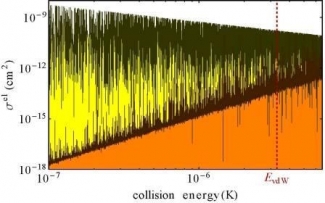Balls of clay may stick to each other when they collide. This is because the original energy they had before the collision gets so mixed up in heating the clay that the balls have none left to separate. Molecules, particularly small ones, don't generally act this way, since there are not many places for the energy to disappear into. However, Michael Mayle, Brandon Ruzic, and Goulven Quéméner have discovered that at ultralow temperatures, some might actually stick. For example, RbCs molecules (cross section below) may have myriad opportunites to waste energy in rotations and vibrations, rather than in getting away from each other. They should eventually escape this mess, but on time scales long enough to affect the experiment.



 The Physics Frontiers Centers (PFC) program supports university-based centers and institutes where the collective efforts of a larger group of individuals can enable transformational advances in the most promising research areas. The program is designed to foster major breakthroughs at the intellectual frontiers of physics by providing needed resources such as combinations of talents, skills, disciplines, and/or specialized infrastructure, not usually available to individual investigators or small groups, in an environment in which the collective efforts of the larger group can be shown to be seminal to promoting significant progress in the science and the education of students. PFCs also include creative, substantive activities aimed at enhancing education, broadening participation of traditionally underrepresented groups, and outreach to the scientific community and general public.
The Physics Frontiers Centers (PFC) program supports university-based centers and institutes where the collective efforts of a larger group of individuals can enable transformational advances in the most promising research areas. The program is designed to foster major breakthroughs at the intellectual frontiers of physics by providing needed resources such as combinations of talents, skills, disciplines, and/or specialized infrastructure, not usually available to individual investigators or small groups, in an environment in which the collective efforts of the larger group can be shown to be seminal to promoting significant progress in the science and the education of students. PFCs also include creative, substantive activities aimed at enhancing education, broadening participation of traditionally underrepresented groups, and outreach to the scientific community and general public.